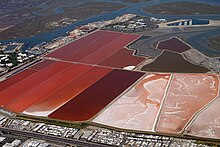Artemia
| Artemia | ||||||||||
|---|---|---|---|---|---|---|---|---|---|---|

Brine shrimp ( Artemia salina ), one of them with eggs |
||||||||||
| Systematics | ||||||||||
|
||||||||||
| Scientific name of the family | ||||||||||
| Artemiidae | ||||||||||
| Grochowski, 1896 | ||||||||||
| Scientific name of the genus | ||||||||||
| Artemia | ||||||||||
| Leach , 1819 |
Artemia (also brine shrimp or salt water crabs , Eng. Brine shrimp ) is the name of a genus of crustaceans, it is the only genus of the family Artemiidae in the order of anostraca (Anostraca). The best known representative of the genus is the Artemia salina ( brine shrimp ).
The genus Artemia was discovered in Lymington , England in 1755 .
Occurrence and way of life
Artemia are typical inhabitants of inland salt waters and can survive the drying up of these waters with their permanent eggs . The species can also colonize new habitats with their permanent eggs, as these are often carried away by water birds.
The animals feed on bacteria and algae, which they filter from the water. By actively excreting salt through the gills, the crabs keep their osmotic value constant, but require up to a third of the energy obtained from their food.
Reproduction takes place via mating or virgin generation , through a hermaphroditic gland that is present in some species, i.e. self-fertilization . Artemia can lay eggs as well as give birth to live young.
Representatives of the genus Artemia occur in huge quantities in salt lakes such as the strongly alkaline Mono Lake in California ( Artemia monica ) or the Great Salt Lake in Utah .
species
The following segregated species of the genus are currently recognized:
- Artemia franciscana Kellogg , 1906: North America, from there abducted worldwide
- Artemia monica Verrill , 1869: exclusively in Mono Lake , California, North America
- Artemia persimilis Piccinelli & Prosdocimi , 1968: Argentina
- Artemia salina ( Linné , 1758) or brine shrimp : Europe, North Africa.
- Artemia sinica Cai , 1989: Central Asia, China
- Artemia tibetiana Abatzopoulos, Zhang & Sorgeloos , 1998: Tibet, China
- Artemia urmiana Gunther , 1899: Iran, Crimea
The species cannot be distinguished using simple methods. Morphological differentiation is only possible in males and is not always reliable. In addition, there are numerous parthenogenetic populations around the globe (thelytok, i.e. only females are known), these are mostly diploid, but sometimes also tri-, tetra- or pentaploid, i. H. the chromosome set is tripled to fivefold; they can be automictic (i.e. all sets of chromosomes are from the same species) or apomictic (i.e. sets of chromosomes from different species are involved, result of hybridization ) and can be locally more abundant than the sexually reproducing species. They cannot be assigned to any biological species and are usually only called "parthenogenetic Artemia strains"; its members are mostly genetically identical clones. They are sometimes referred to with the binomial Artemia parthenogenetica , but this name should be avoided because it brings together very different genetic units and is nomenclaturally invalid.
Significance in aquaristics and aquaculture

Some species of the genus are used live, dried or frozen as fish feed. The nauplii , which can be easily hatched from the permanent eggs, are a very important animal feed in aquaculture and aquaristics . The Artemia eggs can also be decapsulated (peeled) and fed directly. Empty egg shells or unpeeled, unhatched eggs should not be fed, as they are indigestible and in young fish can lead to intestinal obstruction or damage to the intestinal wall due to sharp shell edges.
Artemia eggs can be stored frozen for many years without any loss of hatching rate. Moisture leads to a premature start of development of the cell nuclei and consequently to poor hatching results.
Artemia is also grown and harvested as ornamental fish feed in ponds and lakes in Germany.
literature
- Oliver Drewes: Artemia - The Tadpole Shrimp. VIVARIA Verlag, Meckenheim 2007, ISBN 978-3-9810412-7-9 .
- Atlant Bieri: brine shrimp. SJW 2013, ISBN 978-3-7269-0644-3 , SJW no. 2456.
Web links
- Tadpole Shrimp from Yps
- Artemia as a fish feeder and pet
- Artemia spec. on the website of the Tadpole Shrimp Working Group in Germany
Individual evidence
- ↑ D. Christopher Rogers (2013): Anostraca Catalogus (Crustacea, Branchiopoda). Raffles Bulletin of Zoology 61 (2), pp. 525-546.
- ↑ Ernani JS Pilla & John A. Beardmore (1994): Genetic and morphometric differentiation in Old World bisexual species of Artemia (the brine shrimp). Heredity 73, pp. 47-56.
- ↑ Denton Belk, Jan Brtek (1995): Checklist of the Anostraca. Hydrobiologia 298, pp. 315-353.
- ↑ Erich Eder, Walter Hödl: Why "Tadpole Shrimp"? The practical significance of the large branchiopods for economy, nature conservation and science. In: Stapfia. 42, Linz 1995, pp. 149–158 ( PDF on ZOBODAT ); also catalogs of the Upper Austrian State Museum NF 100, 1996.
- ↑ http://www.aquariummagazin.de Report in the December 2008 edition, p. 10.